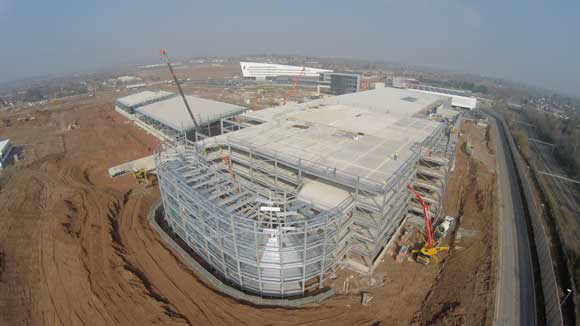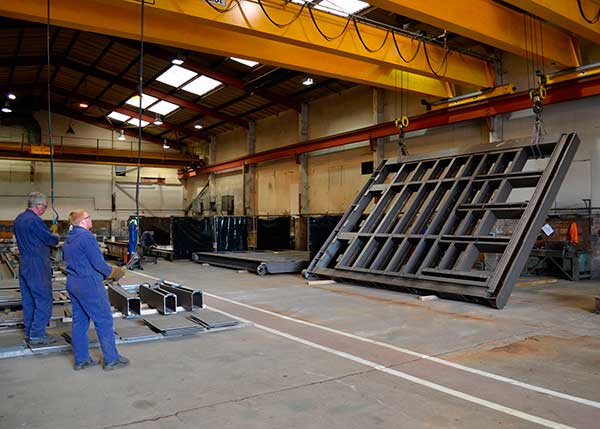Projects and Features
An introduction to corrosion protection

The galvanized M&S car park required 1,200t of steel
NSC looks at corrosion protection, outlining the issues which should be considered and the preventative processes adopted to ensure the durability and longevity of steel structures
Why does steel corrode?
The corrosion of structural steel is an electrochemical process that requires the simultaneous presence of moisture and oxygen. Essentially, the iron in the steel is oxidised to produce rust, which occupies approximately six times the volume of the original material consumed in the process.
What dictates the level of corrosion protection required?
The environment. When steel is in a dry heated interior environment the risk of corrosion is insignificant and no protective coating is necessary. Conversely, a steel structure exposed to an aggressive environment needs to be protected with a high performance treatment and may need to be designed with maintenance in mind if extended life is required.
Surface preparation
Surface preparation is the essential first stage treatment of a steel substrate before the application of any coating, and is generally accepted as being the most important factor affecting the total success of a corrosion protection system. The surface preparation process not only cleans the steel, but also introduces a suitable profile to receive the protective coating.
Grit abrasives are used for high build paint coatings and thermally sprayed metal coatings, which need a coarse angular surface profile to provide a mechanical key. Shot abrasives produce more rounded profiles and are used for thin film paint coatings such as pre-fabrication primers.
Alternative methods of corrosion protection
Paint Coatings: A paint consists of a pigment, dispersed in a binder, and dissolved in a solvent. A modern paint system usually comprises a sequential coating application of paints or alternatively paints applied over metallic coatings to form a ‘duplex’ coating system.
Protective paint systems usually consist of primer, intermediate/build coats and finish coats. Each coating ‘layer’ in any protective system has a specific function, and the different types are applied in a particular sequence.
The method of application of paint systems and the conditions of application have a significant effect on the quality and durability of the coating. Standard methods used to apply paints to structural steelwork include application by brush, roller, conventional air spray and airless spray/electrostatic airless spray.
Hot-dip Galvanizing: Hot-dip galvanizing is a process that involves immersing the steel component to be coated in a bath of molten zinc (at about 450°C) after pickling and fluxing, and then withdrawing it. The immersed surfaces are uniformly coated with zinc alloy and zinc layers that form a metallurgical bond with the substrate. The resulting coating is durable, tough, abrasion resistant, and provides cathodic (sacrificial) protection to any small damaged areas where the steel substrate is exposed.
Commenting on the galvanizing process, Chris Woolridge, Managing Director of Wedge Group Galvanizing says: “Galvanizing is one of the most important elements to consider for construction works, given its ability to effectively protect against rust and corrosion.
“Our Worksop plant was recently called upon by steelwork contractor James Killelea to galvanize 1,900 pieces of steel, totalling 1,200t, for the construction of a multi-storey car park for Marks & Spencer. The nature of the coating means that the life to first maintenance can be in excess of 60 years depending on the environment it is used in.”
Thermally Sprayed Metal Coatings: Thermally sprayed coatings of zinc, aluminium, and zinc aluminium alloys provide corrosion protection to steel structures exposed to aggressive environments. They are also an important component of many ‘duplex’ coating systems. The metal, in powder or wire form, is fed through a special spray gun containing a heat source, which can be either an oxygas flame or an electric arc.
Appropriate specifications
The overall success of a protective coating scheme starts with a well-prepared specification. It is an essential document that is intended to provide clear and precise instructions to the contractor on what is to be done, and how it is to be done. In detail the specification needs to consider the following aspects:
• Environment and access for future maintenance
• Design of the structure
• Surface preparation
• Coating system and application
• Handling and transportation
• Inspection and quality control
• Health and safety
For further information on corrosion protection please visit www.steelconstruction.info/Corrosion_protection
Sponsors
Protective coatings
Gold: Wedge Group Galvanizing
Silver: Jack Tighe Ltd
Bronze: Hempel; Joseph Ash Galvanizing; Sherwin-Williams












